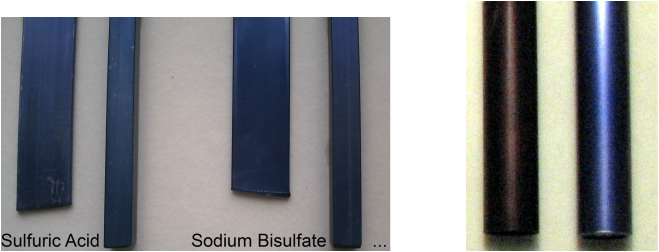Sure. Without flooding you with too much information, watch this video a few times. This guy sums up the process pretty clearly. The video is a tad old, and in that some of his Amazon links to specific products do not exist. However, the information within the video is spot on. Watching a few times will break the mystery for most of you.
One major point that I want to add to the video is the power supply. He is doing aluminum ONLY. Because of this, his power supply is a lower voltage unit from what I have. If you want to anodize titanium also, you will need a power supply that can push upwards of 120V. When you're shopping keep in mind as you look at power supplies, as you go up in voltage, the amperage will go down. My unit is rated for 220V @ 3 amps. The one in the video below 30V @ 10 amps. 30V will not allow you a full spectrum color palette if doing titanium. Likewise, if you're anodizing aluminum crank arms, max amperage you'd need is about 3 amps anyhow BUT better to have it and not need it than to need it and not have it.
Another aspect is the Caswell step-by-step manual. In the video he makes mention of the manual. You can buy supplies and the manual directly from Caswell (where I bought my dye's - some of the best out there) or if your patient, a slightly older version of the manual is floating around for free online, BUT...you will need to find this yourself

. I will not post potential copy-right problems here.
In his video I believe he uses hydroflouric acid (battery acid)...which most of us don't have access to (if you do, lucky you). Hydroflouric acid drastically reduces etching time and frankly is the best to have. But, I have a massively hard time finding store-bought HF, so you use instead, sodium hydrogen sulfate (swimming pool chemical). For etching with sodium hydrogen sulfate follow this link and give it a good read:
There is now an updated video on YouTube here . I did not show the dyeing step and it should be mentioned that after being in the dye, the anodized piece should be placed in boiling water to seal in...
www.observationsblog.com
PLEASE NOTE: If you are etching titanium NOTHING will work except hydroflouric acid due to how hard the surface of titanium is. I have yet to find a supplier or hardware store that sells commercially, i.e. to the average Joe. If you find a source for HF, please let me know, ahhhhh!!!!
There is a company called Multi Etch selling their "proprietary" etch powder which they show can etch titanium but their asking price is pretty expensive...and if I don't find HF soon, I may be resorted to using this product. It does give good results.
Multi-Etch is a safer alternative to hydrofluoric acid for etching titanium. Here's how to get started.

www.multietch.com
Conversely, because they manufacture a chemical, you can reverse-engineer their product using the MSDS on page 3:
For the dyes I bought:

caswellplating.com
On to the video for aluminum...
On to the video for titanium...
If you have any questions, ask em'.

 www.alphaanodising.co.uk
www.alphaanodising.co.uk

